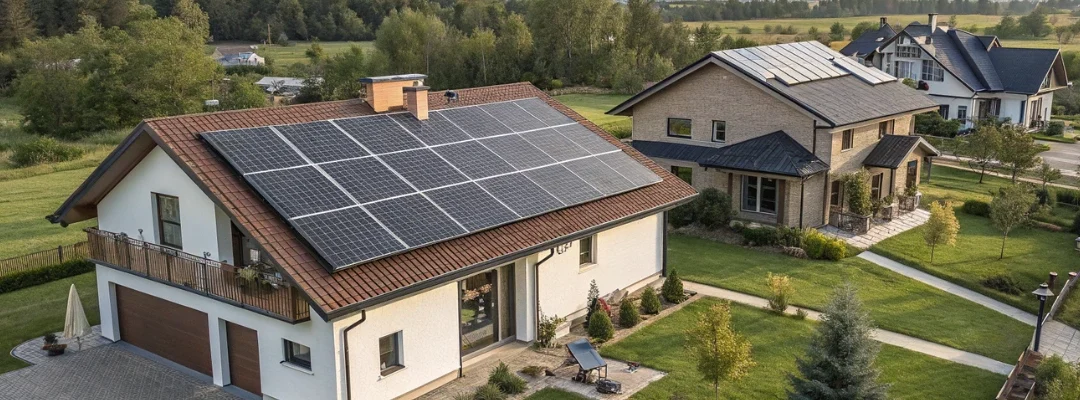Solar Panels for Rental Houses in India – DCR vs Non-DCR Explained
Installing solar panels on a rental house is one of the smartest ways to reduce electricity bills and embrace renewable energy.
However, before investing, it’s important to understand which solar system suits you best — especially the difference between DCR and Non-DCR panels, and how subsidy eligibility affects your final cost.
At Synergy Solar Solutions, we simplify these details so that homeowners and residents of rental properties can make the most informed choice.
Can You Install Solar Panels on a Rental House?
Yes, you can install solar panels on a rental house — with the permission of the property owner and the local DISCOM (Electricity Board).
If the property owner applies for installation and the electricity connection is in their name, the system qualifies for government subsidy (with DCR panels).
If the property is on rent and the installation is done without ownership rights, the system will not receive subsidy, even if DCR panels are used.
In short:
DCR panels with subsidy → For property owners.
No subsidy → For rental property users.
What Are DCR and Non-DCR Solar Panels?
Solar panels in India are categorized based on where their cells and modules are manufactured.
DCR (Domestic Content Requirement) Solar Panels
Entirely made in India (both cells and modules).
Eligible for MNRE rooftop solar subsidy (only for property owners).
Slightly older technology — mostly Poly or standard Mono panels.
Generates around 4 units per kW/day.
Higher initial cost, but the subsidy reduces overall price.
Non-DCR Solar Panels
Made in India using imported solar cells (mainly from China or Vietnam).
Not eligible for government subsidy.
Built with advanced technologies — Mono-PERC, Half-Cut, and Bifacial.
Generates higher output (~ 4.5 units per kW/day).
Cheaper upfront cost, requires fewer panels, and offers same warranty as DCR.
Government Subsidy Eligibility
Under the National Portal for Rooftop Solar (NPRS) by MNRE:
Condition Subsidy Eligibility
Owner installing on rooftop with DCR panels Yes
Rental house user installing system No
Non-DCR panels used No
DCR panels used on non-owner property No
Rooftop installation ≤ 3 kW 40 % subsidy
Rooftop installation > 3 kW 20 % subsidy (for next 7 kW)
Therefore, if you are living in or managing a rental house, the subsidy benefit is not available, but you can still install an efficient Non-DCR on-grid system at a lower cost. DCR vs Non-DCR Solar Panels – Detailed Comparison
Feature DCR Solar Panel Non-DCR Solar Panel
Manufacturing Fully Made in India (cells + modules) Made in India with imported cells
Govt Subsidy Eligibility Yes (for owners only) No
Cost (before subsidy) ₹ 65 000 – ₹ 70 000 per kW ₹ 50 000 – ₹ 55 000 per kW
Cost (after subsidy for 3 kW) ₹ 1.2 – ₹ 1.3 lakh ₹ 1.4 – ₹ 1.5 lakh (no subsidy)
Avg Power Generation per kW/day 4 units 4.5 units (+ 12 %)
Technology Poly / Standard Mono Mono-PERC / Half-Cut / Bifacial
Roof Space Required More (6–7 panels for 3 kW) Less (5–6 panels for 3 kW)
Warranty 25 + years performance 25 + years performance
Best For Homeowners eligible for subsidy Rental house installations (no subsidy)
Example – 3 kW System Comparison
Parameter DCR (With Subsidy) Non-DCR (Without Subsidy)
System Cost ₹ 2 ,00 ,000 ₹ 1 ,50 ,000
Govt Subsidy ₹ 72 ,000 Not applicable
Final Cost ₹ 1 ,28 ,000 ₹ 1 ,50 ,000
Daily Units Generated 12 13.5
Annual Units Generated ~ 4 ,380 ~ 4 ,900
ROI Period 3.5 – 4 years 3 – 3.5 years
Insight:
Even though DCR systems receive subsidy, the final cost and annual generation value are almost equal to Non-DCR systems.
Non-DCR panels generate more electricity and require fewer modules, offering better efficiency for rental properties.
Which System is Best for Rental Houses?
For rental houses, the Non-DCR solar system is the most practical and affordable solution.
Here’s why:
No Subsidy Hassle: Non-DCR systems are free from government documentation and approval processes.
Lower Upfront Cost: Even without subsidy, Non-DCR panels are cheaper.
Higher Power Generation: Around 12 % more electricity than DCR panels.
Fewer Panels Needed: Saves roof space – ideal for compact rental rooftops.
Same Warranty & Lifespan: 25 + years performance, 10–12 years product warranty.
Advanced Technology: Uses the latest Mono-PERC and Half-Cut cell technology.
So, for anyone installing solar in a rental property, a Non-DCR on-grid system offers the best mix of efficiency, flexibility, and ROI.
When Should You Choose DCR Panels?
If you are the owner of the rental house (not the tenant) and the electricity connection is in your name, installing DCR panels allows you to claim subsidy benefits.
Choose DCR when:
You own the property.
You plan long-term residence (10 + years).
You want MNRE subsidy through the National Portal.
Even though DCR uses slightly older technology, the subsidy brings the net cost close to Non-DCR systems.
Key Takeaways
Subsidy Eligibility: Only DCR panels used by property owners qualify.
Rental Houses: Non-DCR systems are recommended — cost-effective and efficient.
Performance: Non-DCR panels produce ≈ 0.5 unit more per kW/day.
Panel Count: Non-DCR systems need fewer modules — ideal for small rooftops.
Warranty: Both offer the same 25 + year performance guarantee.
Cost Balance: DCR (with subsidy) ≈ Non-DCR (without subsidy).
Example ROI Calculation
Type Investment (₹) Avg Monthly Units Avg Monthly Savings (@₹7/unit) Payback Period
DCR (With Subsidy) ₹ 1.28 L 360 – 400 ₹ 2 ,500 – ₹ 2 ,800 3.5 years
Non-DCR (Without Subsidy) ₹ 1.50 L 400 – 450 ₹ 3 ,000 – ₹ 3 ,200 3 years
After 3 to 4 years, both systems generate free electricity for over two decades.
Why Choose Synergy Solar Solutions
MNRE-approved EPC contractor for DCR & Non-DCR systems.
Expert in on-grid installations for residential & rental houses.
Assistance with subsidy applications (for owners).
Premium brands – Waaree, Delta, Loom, Havells.
Over 500 residential and rental projects installed across India.
Synergy Solar Solutions helps both owners and rental property users go solar affordably and efficiently.
Frequently Asked Questions
Can a rental house get solar subsidy in India?
No. Only the property owner is eligible for subsidy when using DCR panels under the MNRE scheme.
Are Non-DCR panels allowed for rental houses?
Yes. They are fully approved under BIS standards and commonly used across India — but not eligible for subsidy.
Which is better for rental houses – DCR or Non-DCR?
Non-DCR is better for rental houses – it’s low-cost, high-efficiency, needs fewer panels, and offers equal warranty.
Do Non-DCR panels generate more power?
Yes. Non-DCR panels generate ≈ 4.5 units/kW/day — about 12 % more than DCR panels.
What about maintenance and warranty?
Both DCR and Non-DCR systems need simple panel cleaning and offer 25 + years performance warranty.
If the rental property owner applies for subsidy, is it allowed?
Yes. If the owner’s name is on the electricity connection, the owner can install DCR panels and claim the subsidy.

